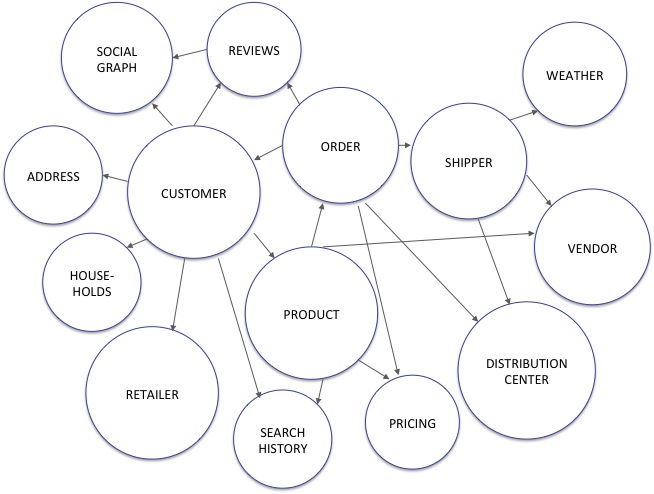Semantic Retail
Why would a retailer care about the semantic web, surely this is just another technology fad that the IT department can distract itself with instead of delivering faster transaction systems or more accurate and up-to-date reports? Not so. If fact it turns out semantic technology may enable robust solutions to your retail business users' most pressing problems. (December 2011)

Common Outcomes of Data Bottlenecks
Retail information bottlenecks are best understood in the context of the value chain: Assortment Planning; Merchandising; Availability; Fulfillment; Marketing and Customer Loyalty.
- Information about products is not as good as it could be - data received from vendor community can be incomplete, inconsistent and sometimes just plain incorrect. At best poor item information holds up the Assortment planning process and at worst creates lost sales or causes compliance problems with taxes and fees.
- Poor item detail data impairs the Search and Browse experience, a problem that results in early session abandonment and sales lost to competitors
- Maintaining price competitiveness is difficult in today's environment of flash-sales, offers and aggregators where consumers are able to discover the cheapest prices that are only a click away - this will affect online and in-store items alike.
- Incorporating Drop Ship Vendors and 3rd party logistics operations will increase the assortment, this obscures visibility ultimately leaving items unavailable for sale and back-orders leading to a poor customer experience and lost sales.
- Finally and most significantly, where customer data is not available to every process leaves both Site Merchants and Marketing at a competitive disadvantage.
Behaviors of the Data Starved Organization
How much time is spent by the Engineering, Reporting or Business departments wrangling data to make a critical decision? The wrangling: first identify the data and locate the source, ensure it is both accurate and viable and finally formatting it into a way that a person or system can act on it.
For strategic decisions this is an overhead that is both acknowledged and justified. However for daily tactical decisions, the difficulty in getting data is often treated as dirty laundry, neither being recognized or accounted for - which means not only a hidden resource / time cost, but more significantly, the opportunity cost of being less agile in response to market, competitor or external factors.
Making Sense of the Data
Once the underlying data around Item, Customer, Inbound Order and Outbound Order is properly mapped into the retailer schema (or Master Data Management System if available) then it opens up whole new capabilities for the IT department to deliver the systems that create competitive advantage.
| Data Element | Mapping | Capabilities |
|---|---|---|
| Item | Dimensionality of all attributes, Item class(es), Item Component Breakdown, Public Domain Information Concerning Item, Product Reviews and Ratings | Improved search via Google Shopping, LinkedOpenCommerce, Bing and Siri, Price Comparisons, Competitive Market Analysis |
| Customer | Simple customer attributes, Social Graph Data and Psycho-demographic profiles, Online customer behaviors, Customer transaction history | Basic Segmentation, Simple Collaborative Filtering, Social Shopping, Complex Recommendation, Personal Site Curation (Pico-segmentation); Dynamic User Experiences |
| Inbound Order | Order Breakdown details, Manufacturer Vendor details, Payment Details, Shipment Tracking, Weather Status, Labor Issues | Ability to better manage inventory by machine insight into order status and ability to expedite orders and smooth out peaks and troughs in availability, ability to carefully manage costs |
| Outbound Order | Order details, Shipper Details, Shipping Statuses | Manage Order Breakdown Details; Shipper Details; Fees, Tax and Customs Payment Status |
The Item, Customer, Inbound and Outbound Lifecycles are documented here.
First Retail's Vision of Semantic Retail
If First Retail achieves its objectives in Semantic Retail, then the term will disappear - all data will be marked up to an extent that machines will read the data about the retail process transaction and make decisions with minimal human curation. Agent Technologies will perform shopping tasks for the consumer.
Examples of thisinclude:
- Using semantically available weather data over time mapped to sales to determine the effects of weather on sales and ultimately to predict it that will allow pro-active availability strategies or the ability to track a shipment from manufacturer to distribution center, via vendor, shipper, customs and finally freight company to the back door and monitor for any conditions that will impede with in any way (e.g. GoodRoute for HazMat transportation
- Using Social Graph data mapped to the Product Taxonomy to create recommended products for own purchase (e.g. ShoppyCat) and for gifts (e.g. Wantful)
- For the consumer to be able to issue a request in some sort of unstructured text (or verbally like with Siri) and then to match those requests with offers in real time (in the same way that Zaarly and Ubokia envisage, but for Vendors in addition to your networks)
First Retail is creating a Semantic Matching Engine that will ingest item catalogs at web-scale in real-time. Coupled to its Unstructured Text Classification capability, this will form part of the new infrastructure required to succeed as a Retailer in tomorrow's marketplace - for further information please send an email to info@firstretail.com
Also Read
- How To Leverage Structured Markup To Create E-Commerce Web Portals Search Engine Land (Nov 2011)
- The Value of Semantic Markup to Retailers Semantic Web (Nov 2011)
- Good Relations Website - The Web Vocabulary for E-Commerce Martin Hepp